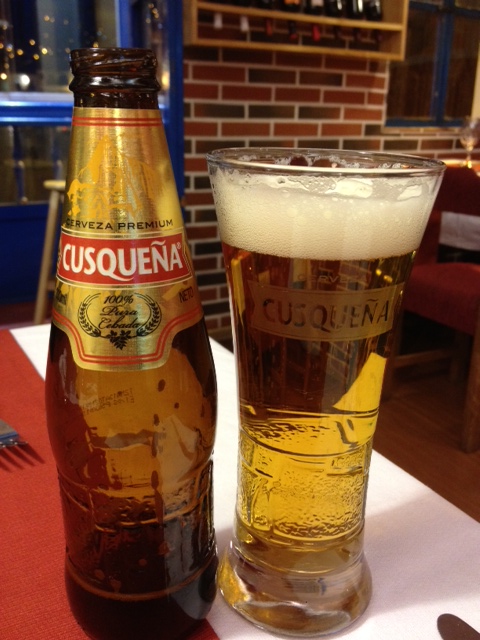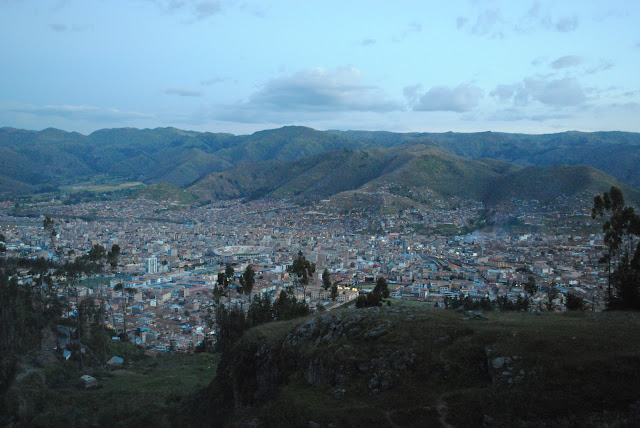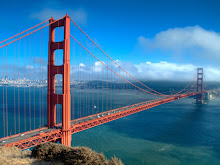In the afternoon we were picked up at the hotel and dropped off at Plaza Armas (the main plaza, remember?) for a Cusco city tour. This main plaza was originally the main plaza for the Inca town. Although our tour guide told us back during the Inca Empire the square was much, much bigger. Since then the land was so valuable in the center of the city that houses and buildings have since gone up and taken part of the plaza.
Across from the plaza was the Cathedral. I think it's called the Cathedral of the Cusco. This is where our tour began.
Just like all the other 17 Catholic churches in Cusco (yes, you read that correctly, there are a ton of them!), photography was not allowed. Thank goodness Joe learned from his mom and was able to snap a few with his phone very discretely. There were 12 alters in the Cathedral and almost every single one was pure gold or silver. I don't know if you can tell from these pictures, but there were also mirrors all over the interior. Our tour guide said that was because when the Spaniards conquered the Incans and were trying to convert them to Catholicism the best way to get them into the churches was by the mirrors. Incans had never seen themselves in the mirror before and were fascinated by it.
Carrying on with the tour, our tour guide pointed out some original Inca walls. These walls were usually easy to spot because of how well the stones locked together without any mortar. I'll show you lots more, don't worry. I felt the need to model in front of one. You know, just so I could prove that I was there!
This is Saint Domingus. I have nothing more to tell you about it because I don't remember... or wasn't listening. And that kid next to us? He was probably trying to sell us something. At least that is a good guess.
Inside the church was a courtyard and multiple temples worshiping different phenomenons basically. Whatever was unexplainable the Incans worshipped it. No one could explain lightning so they worshipped it, the stars helped tell time and seasons but they didn't know why so they worshipped them and so on.
Here's our tour guide, Beto. He was great. He walked with a cane, but he called it his power stick. To make sure everyone was following correctly (since there were sometimes lots of other tours walking around and it was easy to accidentally follow the wrong group). He would wave the cane in the air and call for the power stick group. He also taught us a Quechua phrase... "haku haku!" It basically means "let's get going." He would say it each time our tour was moving on to the next location and such. Needless to say we used that phrase for the rest of our trip.
To give some background, Quechua is the native Inca language and is still spoke by a small population in Peru today. It's amazing how some small areas of the country have carried on that tradition for hundreds of years.
This turned out to be a pretty neat picture (pats herself on the back). It's on the back side of Saint Domingus and you actually can't quite see it, but a bit farther to the right of the frame is the Temple of the Sun. Like I said, the Incans worshipped everything. The road down below is the Avenue of the Sun. It was a main street through Cusco and we walked along it a couple times.
Here is another angle. The Temple of the Sun is behind the dark gray wall just below the three arches. The picture was taken from the Avenue of the Sun. It all works together!
After a little walking around Cusco we hopped in a bus and were off to a few locations nearby. First stop was Saqsaywaman (pronounced Sexy Woman). Even Beto told us we'd never forget this name since it was so easy to remember. Here is what the map tells us about this location: The remains and foundations of a colossal structure formed by three-tiered defense walls made of stones that fit with razor-sharp precision. Saqsaywaman which means "Contended Falcon," was built in some 77 years under the rule of Incas Tupac Yupanki and Wayna Qhapaq. It was dismantled by the Spaniards from 1537 to 1561 and converted into a quarry to build a Cathedral, a number of temples, and houses for themselves. Four well-defined sections can be clearly identified: The Fortress or Walls built with cyclopean stonemasonry arranged in zigzag form, that face the second section: the Chuquipampa Square or Esplanade. The largest stone weighs about 70 tons! The fortified Towers and the Suchua hill, located opposite the Walls, characterize the other two sections. The festival of Inti Raymi takes place here every June 24th.
Here is a woman with her traditional Peruvian dress with her alpaca. She most likely asked us if we wanted a picture of her... for one or two soles (the Peruvian currency). If it wasn't the little girls carrying the baby goats on the street of Cusco asking us, it was the lady with the alpaca at some Inca ruin asking. They were everywhere. Seriously we probably got asked 30 times throughout our trip if we wanted a picture of them. Instead I snapped one when she turned her back. Shhhh...
There's the city of Cusco down in the valley.
Joe said he wanted his picture taken with a sexy woman at Sexy Woman. Done!
Just look at the size of these rocks! We used Joe to help show them to scale.
Thus begins our fascination of doors at the Inca ruins. This one is actually really tall. You'll see more and the rest are much shorter. If I remember correctly the Incas were a short population so they built doors that suited them. This one must have been for a giant or something.
Right about at this time we met a very nice couple from Ireland. It's easy to meet people and strike up a conversation when we kept asking people to take our picture. This couple was very nice about helping us and we were happy to return the favor. Turns out they were on their honeymoon... for three weeks! I believe they had already spent some time in La Paz, Bolivia, now Peru and the end of their trip would be a couple days in Miami. Wouldn't it be nice!
Here are the Fortress Walls laid out in the zigzag form that was mentioned earlier. You can tell by how small those people are, this place was huge!
This is one of the famous 12 corner stones. Beto pointed it out and counted all 12 for us. Can you spot them all? It represents the 12 months of the calendar year. The Incas were not only worshipping the sun and stars, they also used them to tell time and seasons. They were very advanced!
Let me take this opportunity to introduce you to one more "must eat/drink" item we crossed off the list. Actually this one made the list only after we stepped foot in Peru and started seeing signs and adds for this beer everywhere. Cusqueña is a Peruvian beer that usually comes served in it's own special glass (you know, just like Sam Adams or Stella both have their own special glass). So special Joe tried to buy it at the restaurant. I'll save that story for later in this post. I want to point out the detail on the bottom of the bottle and glass. See the Inca stones in the etched glass? They actually include a 12 corner stone on there. Pretty special!
Back to Sexy Woman... Joe showed off his Hawkeye pride, Inca style.
Next on the bus trip was Puka Pukara. Here is what our map has to say: This used to be a checkpoint and administrative center, a military headquarter and a warehouse for food. When the Inca visited the Tambomachay baths all of the dancers lodged here. Puka Pukara means "Red Fortress." it was built on a buttress and surrounded by a wall and hillside terraces for containment. The core is a small square with several rooms. There are also hillside farming terraces and water channels as well as aqueducts and roads. Some remarkable architectural features include a series of cascading water springs and double-threshold entrance to the site. Such characteristics suggest that it was a military fortress and a watchtower to control the access to Tambomachay.
And buzz kill... we didn't actually get out of the bus at this location. Beto asked if anyone wanted to get out and take pictures, but the fortress was truly ruins. Not much was left of the structure so we carried on to our next location.
Next was the nearby Tambomachay (not sure how to pronounce this one!) which Puka Pukara supposedly guarded. A Place where the Inca lodged regularly. Tambomachay means "Resort." It is also known as "The Baths of the Princess." Two aqueducts provide spring water all year round. It has a ritual fountain and three terraces built with stones or irregular polyhedral shape that fit together perfectly without mortar of any kind. It was built around 1500 A.D. with limestone found nearby and cut in polygonal form. There are two main sectors: above, water fountains with hillside farming terraces and superb hydraulic system; below, a main fountain with two channels that were used as ceremonial streams, since water was worshiped as the source of life.
I didn't notice this at first, but check out how similar our poses are below. Our legs are pretty much mirroring each other. Trust me, that was not planned! Great minds think alike!
I spy with my little eye... Joe!
Our next and final stop on the Cusco city tour was Q'enqo (Cane-ko). According to our map: Religious archaeological group for the worship to fertility. Q'enqo means "labyrinth." An amphitheater, a central monolith, underground galleries and vestiges of pottery are indications that important ceremonies took place here. A 20 foot tall on-site carved stone monolith was vandalized and defaced by Spaniards in their attempt to do away with idolatry. On a table at the bottom of the semicircular cave sacred rites are thought to have taken place. On top of a rock outcrop there is a set of carved staircases and seats, and a winding water channel, which ended in a circular depression and represented first a snake, then the head of a cat and finally a bird which were elements of Inca religious symbolism. There are also two cylindrical shapes, which may have been used as an astronomic observatory.
Oh hello again, Beto.
It was a bit eerie once we got inside the cave. This is where they performed sacrifices! Although the Inca Empire rarely sacrificed humans, it was still a bit creepy to be inside there. I believe Beto said the Incas only sacrificed humans after a big event like an earthquake or natural disaster. Otherwise they used animals (like alpacas or chickens) as the offering.
This was the end of the tour, but before we got back on the bus for our trip back to Cusco we snapped a few more pictures. The sun was starting to set and the city was starting to light up.
Any guesses what we had for dinner? That's right, we enjoyed another pizzeria. Couldn't tell you the name of this place, but Joe and I both agreed this was the best pizza we had on the trip. I think we got Hawaiian pizza that night? Back to the story about Joe trying to buy the Cusqueña beer. The glass he was served was so cool, we knew it was the perfect souvenir. The problem was our waitress didn't speak much English at all. That was all fine and dandy when it came to ordering our food. I speak a bit of Spanish and it's very easy to just point at the menu to show her what you want to eat. She was a bit flustered when we asked how much they'd sell it for. After consulting with her manager the price was much higher than we were willing to pay. Although we put up a fight and tried to barter, they weren't budging. Don't worry, we did end up finding the glass at a market and bought it for less.
We're on a roll here, but we did check off one more "must eat/drink" item this night. Pisco is a grape brandy made in Peru and Chile. The popular way to drink it in Chile was with Coke and they called it Piscola... very clever. In Peru the popular drink was Pisco Sour. I couldn't tell you what's in it, but I ordered it and I drank the whole thing.
I'm just getting started. Stay tuned for more from our Peru adventure!
























































1 comment:
These are great pictures! I am enjoying hearing about your trip on the blog :) Hope you guys had a great time - miss you!!
Post a Comment